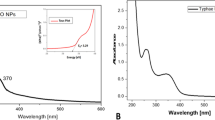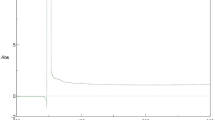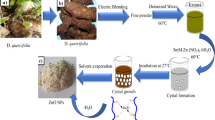Abstract
Titanium dioxide nanoparticles (TiO2 NPs) are considered to be among the best photocatalytic materials due to their long-term thermodynamic stability, strong oxidizing power, and relative non-toxicity. Nano-preparations with TiO2 NPs are currently under investigation as novel treatments for acne vulgaris, recurrent condyloma acuminata, atopic dermatitis, hyperpigmented skin lesions, and other non-dermatologic diseases. The present study was to investigate the acaricidal and larvicidal activity of synthesized TiO2 NPs utilizing leaf aqueous extract of Mangifera indica L. (Anacardiaceae) against hematophagous parasites. The anti-parasitic activity of TiO2 NPs against the larvae of Rhipicephalus (Boophilus) microplus, Hyalomma anatolicum anatolicum and Haemaphysalis bispinosa (Acari: Ixodidae), fourth instar larvae of Anopheles subpictus, and Culex quinquefasciatus (Diptera: Culicidae) were assessed. The green synthesized TiO2 NPs were analyzed by UV–Vis, FTIR, X-ray diffraction (XRD), AFM, SEM, and TEM. The XRD analysis of synthesized TiO2 NPs revealed the dominant peak at 2θ value of 27.81 which matched the 110 crystallographic plane of the rutile structure indicating the crystal structure. The FTIR spectra exhibited a prominent peak at 3,448 cm−1 and showed OH stretching due to the alcoholic group, and the OH group may act as a capping agent. The SEM images of TiO2 NPs displayed spherical, oval in shape, individual, and some in aggregates. Characterization of the synthesized TiO2 NPs using AFM offered three-dimensional visualization and uneven surface morphology. The TEM micrograph showed agglomerates, round and slight elongation with an average size of 30 ± 5 nm. The maximum efficacy was observed in synthesized TiO2 NPs against the larvae of R. microplus, Hyalomma anatolicum anatolicum, Haemaphysalis bispinosa, A. subpictus, and Culex quinquefasciatus with LC50 value of 28.56, 33.17, 23.81, 5.84, and 4.34 mg/L, respectively. In the present study, a novel, simple, and eco-friendly approach has been suggested to control blood-feeding parasites.





Similar content being viewed by others
References
Bae TH, Tak TM (2005) Preparation of TiO2 self-assembled polymeric nanocomposite membranes and examination of their fouling mitigation effects in a membrane bioreactor system. J Membr Sci 249:1–8
Bhosa GS, Lubega A, Musisi N, Kyegombe DB, Waako P, Okeng JO, Odyek O (2007) The activity of Mangifera indica L. leaf extracts against the tetanus causing bacterium, Clostridium tetani. Afr J Ecol 45:54–58
Boujday F, Wunsch P, Portes JF, Bocquet, Justin CC (2004) Photo catalytic and electronic properties of TiO2 powders elaborated by sol–gel route and supercritical drying. Sol Energy Mater Sol Cell 83:421–433
Carp O, Huisman CL, Reller A (2004) Photo induced reactivity of titanium dioxide. Prog Solid State Chem 32:133–177
Chandra G, Bhattacharjee I, Chatterjee S (2010) A review on Anopheles subpictus Grassi a biological vector. Acta Trop 15(2):142–154
Chatterjee SN, Chandra G (2000) Role of Anopheles subpictus as a primary vector of malaria in an area in India. Jpn J Trop Med Hyg 28(3):177–181
David MR, Ribeiro GS, de Freitas RM (2012) Bionomics of Culex quinquefasciatus within urban areas of Rio de Janeiro, Southeastern Brazil. Rev Saude Publica 46(5):858–865
Fernandes FF, Freitas EPS (2007) Acaricidal activity of an oleoresinous extract from Copaifera reticulata (Leguminosae: Caesalpinioideae) against larvae of the southern cattle tick, Rhipicephalus (Boophilus) microplus (Acari: Ixodidae). Vet Parasitol 147:150–154
Fisher J, Egerton TA (2001) Titanium compounds, inorganic. In Kirk-Othmer encyclopedia of chemical technology. Wiley, New York, p 16
Ghosh S, Bansal GC, Gupta SC, Ray D, Khan MQ, Irshad H, Shahiduzzaman M, Seitzer U, Ahmed JS (2007) Status of tick distribution in Bangladesh, India and Pakistan. Parasitol Res 101(2):S207–216
Ghosh AK, Devenport M, Jethwaney D, Kalume DE, Pandey A, Anderson VE, Sultan AA, Kumar N, Jacobs-Lorena M (2009) Malaria parasite invasion of the mosquito salivary gland requires interaction between the Plasmodium TRAP and the Anopheles saglin proteins. PLoS Pathog 5:e1000265
Guerrero FD, Lovis L, Martins JR (2012) Acaricide resistance mechanisms in Rhipicephalus (Boophilus) microplus. Rev Bras Parasitol Vet Jaboticabal 21(1):1–6
Helen PAM, Aswathy MR, Deepthi KG, Rathi RM, Jaison Joseph J, Jaya Sree S (2013) Phytochemical analysis and anticancer activity of leaf extract of Mangifera indica (Kotttukonam Varika). IJPSR 4(2):819–824
Hoogstraal H (1979) The epidemiology of tick-borne Crimean-Congo haemorrhagic fever in Asia, Europe and Africa. J Med Entomol 15:307–417
Hooshmand–Rad P, Hawa NJ (1973) Transmission of Theileria hirciin sheep by Hyalomma anatolicum anatolicum. Trop Anim Health Prod 5:103–109
Hudlikar M, Joglekar S, Dhaygude M, Kodam K (2012) Green synthesis of TiO2 nanoparticles by using aqueous extract of Jatropha curcas L latex. Mater Lett 75:196–199
Jha AK, Prasad K, Kulkarni AR (2009) Synthesis of TiO2 nanoparticles using microorganisms. Colloids Surf B: Biointerfaces 71(2):226–229
Jones CE, Lounibos LP, Marra PP, Kilpatrick AM (2012) Rainfall influences survival of Culex pipiens (Diptera: Culicidae) in a residential neighborhood in the mid-Atlantic United States. J Med Entomol 49(3):467–473
Kaida T, Kobayashi K, Adachi M, Suzuki F (2004) Optical characteristics of titanium oxide interference film and the film laminated with oxides and their applications for cosmetics. J Cosmet Sci 55:219–220
Kamaraj C, Bagavan A, Rahuman AA, Zahir AA, Elango G, Pandiyan G (2009) Larvicidal potential of medicinal plant extracts against Anopheles subpictus Grassi and Culex tritaeniorhynchus Giles (Diptera: Culicidae). Parasitol Res 104:1163–1171
Kasturi J, Veerapandian S, Rajendiran N (2009) Biological synthesis of silver and gold nanoparticles using apiin as reducing agent. Colloids Surf B 68:55–60
Kirthi AV, Rahuman AA, Rajakumar G, Marimuthu S, Santhoshkumar T, Jayaseelan C, Elango G, Abduz Zahir A, Kamaraj C, Bagavan A (2011) Biosynthesis of titanium dioxide nanoparticles using bacterium Bacillus subtilis. Mat Lett 65:2745–2747
Klempner MS, Unnasch TR, Hu LT (2007) Taking a bite out of vector-transmitted infectious diseases. N Engl J Med 356:2567–2569
Kumar A, Shukla R, Singh P, Prasad CS, Dubey NK (2008) Assessment of Thymus vulgaris L. essential oil as a safe botanical preservative against post harvest fungal infestation of food commodities. Innov Food Sci Emerg Technol 9:575–580
Latif AA (1994) Theileriosis of sheep in the Sudan: a case report. In: Ata-Elmanan AM, Kheir SM (eds) Proceedings of a workshop on Tropical Theileriosis held at the veterinary Association Residence, Khartoum 4–5.
Likhitwitayawuid K, Chanmahasathien W, Ruangrungsi N, Krungkrai J (1998) Antimalarial xanthones from Garcinia cowa. Planta Med 64:281–282
Ling LT, Yap SA, Radhakrishnan AK, Subrahmanian T, Cheng HM, Palanisamy UD (2009) Standardised Mangifera indica extract an ideal antioxidant. Food Chem 113:1154–1159
Liu H, Wang K, Tang Y, Sun Z, Jian L, Li Z, Wu B, Huang C (2011) Structure elucidation of in vivo and in vitro metabolites of mangiferin. J Pharm Biomed Anal 55:1075–1082
Lok C, Ho C, Chen R, He Q, Yu W, Sun H, Tam PK, Chiu J, Che C (2007) Silver nanoparticles: partial oxidation and antibacterial activities. J Biol Inorg Chem 12:527–534
Mahapatra O, Bhagat M, Gopalakrishnana C, Arunachalam KD (2008) Ultrafine dispersed CuO nanoparticles and their antibacterial activity. J Exp Nanosci 3:185–193
Mak NK, Li WK, Zhang M, Wong RN, Tai LS, Yung KK, Leung HW (2000) Effects of euxanthone on neuronal differentiation. Life Sci 66:347–354
Marimuthu S, Rahuman AA, Jayaseelan C, Kirthi AV, Santhoshkumar T, Velayutham K, Bagavan A, Kamaraj C, Elango G, Iyappan M, Siva C, Karthik L, Bhaskara Rao KV (2013) Acaricidal activity of synthesized titanium dioxide nanoparticles using Calotropis gigantea against Rhipicephalus microplus and Haemaphysalis bispinosa. Asian Pac J Trop Med 412–420
Moolhuijzen PM, Tabor EL, Morgan JAT, Valle MR, Peterson DG, Dowd SE, Guerrero FD, Bellgard MI, Appels R (2011) The complexity of Rhipicephalus (Boophilus) microplus genome characterised through detailed analysis of two BAC clones. BMC Res Notes 4:254
Narayan KB, Sakthivel N (2008) Coriander leaf mediated biosynthesis of gold nanoparticles. Mater Lett 62:4588–4590
Nyamador WS, Ketoh GK, Amevoin K, Nuto Y, Koumaglo HK, Glitho IA (2010) Variation in the susceptibility of two Calloso bruchus species to essential oils. J Stored Prod Res 46:48–51
Philip D (2010) Rapid green synthesis of spherical gold nanoparticles using Mangifera indica leaf. Spectrochim Acta A 77:807–810
Priyaragini SV, Swetha D, Karthik L, Gaurav K, Bhaskara Rao KV (2013) Evaluating the effectiveness of marine actinobacterial extract and its mediated titanium dioxide nanoparticle in the degradation of azo dyes. J Environ Sci 26(4):775–782
Rahuman AA, Gopalakrishnan G, Ghouse BS, Arumugam S, Himalayan B (2000) Effect of Feronia limonia on mosquito larvae. Fitoterapia 71(5):553–555
Rajakumar G, Rahuman AA (2011) Larvicidal activity of synthesized silver nanoparticles using Eclipta prostrata leaf extract against filariasis and malaria vectors. Acta Trop 118 (3):196–203
Rajakumar G, Rahuman AA, Priyamvada B, Gopiesh Khanna V, Kishore Kumar D, Sujin PJ (2012a) Eclipta prostrata leaf aqueous extract mediated synthesis of titanium dioxide nanoparticles. Mater Lett 68:115–117
Rajakumar G, Rahuman AA, Roopan SM, Khanna VG, Elango G, Kamaraj C, Zahir AA, Velayutham K (2012b) Fungus-mediated biosynthesis and characterization of TiO2 nanoparticles and their activity against pathogenic bacteria. Spectrochim Acta A Mol Biomol Spectrosc 91:23–29
Rajakumar G, Rahuman AA, Jayaseelan C, Santhoshkumar T, Marimuthu S, Kamaraj C, Bagavan A, Zahir AA, Kirthi AV, Elango G, Arora P, Karthikeyan R, Manikandan S, Jose S (2014) Solanum trilobatum extract-mediated synthesis of titanium dioxide nanoparticles to control Pediculus humanus capitis, Hyalomma anatolicum anatolicum and Anopheles subpictus. Parasitol Res 113(2):469–479
Reddy PJ, Krishna D, Murthy US, Jamil K (1992) A microcomputer FORTRAN program for rapid determination of lethal concentration of biocides in mosquito control. Comput Appl Biosci 8:209–213
Reisen WK, Lothrop HD, Lothrop B (2003) Factors influencing the outcome of mark-release-recapture studies with Culex tarsalis (Diptera: Culicidae). J Med Entomol 40(6):820–829
Riscoe M, Kelly JX, Winter R (2005) Xanthones as antimalarial agents: discovery, mode of action, and optimization. Curr Med Chem 12:2539–2549
Rodríguez J, Di Pierro D, Gioia M, Monaco S, Delgado R, Coletta M, Marini S (2006) Effects of a natural extract from Mangifera indica L, and its active compound, mangiferin, on energy state and lipid peroxidation of red blood cells. Biochim Biophys Acta 1760:1333–1342
Roopan SM, Bharathi A, Prabhakarn A, Rahuman AA, Velayutham K, Rajakumar G, Padmaja RD, Lekshmi M, Madhumitha G (2012) Efficient phyto-synthesis and structural characterization of rutile TiO2 nanoparticles using Annona squamosa peel extract. Spectrochim Acta A Mol Biomol Spectrosc 98:86–90
Ruiz AM, Sakai G, Cornet A, Shimanoe K, Morante JR, Yamazoe N (2004) Microstructure control of thermally stable TiO2 obtained by hydrothermal process for gas sensors. Sensors Actuators B Chem 103:312–317
Salam HA, Rajiv P, Kamaraj M, Jagadeeswaran P, Gunalan S, Sivaraj R (2012) Plants: green route for nanoparticle synthesis. I Res J Biol Sci 1:85–90
Shankar SS, Rai A, Ahmad A, Sastry M (2004) Rapid synthesis of Au, Ag and bimetallic Au core-Ag shell nanoparticles using neem (Azadirachta indica) leaf broth. J Colloid Interface Sci 275:496–502
Sundrarajan M, Gowri S (2011) Green synthesis of titanium dioxide nanoparticles by Nyctanthes arbor-tristis leaves extract. Chalcogenide Lett 8(8):447–451
Velayutham K, Rahuman AA, Rajakumar G, Santhoshkumar T, Marimuthu S, Jayaseelan C, Bagavan A, Kirthi AV, Kamaraj C, Zahir AA, Elango G (2012) Evaluation of Catharanthus roseus leaf extract mediated biosynthesis of titanium dioxide nanoparticles against Hippobosca maculata and Bovicola ovis. Parasitol Res 111(6):2329–2337
Wang C, Deng ZX, Li Y (2001) The synthesis of nanocrystalline anatase and rutile titania in mixed organic media. Inorg Chem 40:5210–5214
WHO (1996) Report of the WHO informal consultation on the evaluation on the testing of insecticides. CTD/WHO PES/IC/ 96.1. Geneva p. 69
Acknowledgments
The authors are grateful to the management of C. Abdul Hakeem College, Principal, and HOD of Zoology for their help and support to carry out the present study.
Author information
Authors and Affiliations
Corresponding author
Rights and permissions
About this article
Cite this article
Rajakumar, G., Rahuman, A.A., Roopan, S.M. et al. Efficacy of larvicidal activity of green synthesized titanium dioxide nanoparticles using Mangifera indica extract against blood-feeding parasites. Parasitol Res 114, 571–581 (2015). https://doi.org/10.1007/s00436-014-4219-8
Received:
Accepted:
Published:
Issue Date:
DOI: https://doi.org/10.1007/s00436-014-4219-8




